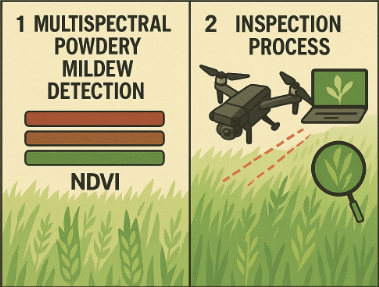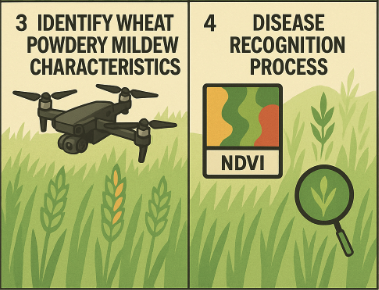Spot Wheat Powdery Mildew Early with Drone Technology


– Reduce Losses, Gain Peace of Mind!
Once powdery mildew breaks out, the cost of spraying doubles and yields may drop by 20%—but if caught early, the outcome can be completely different.
Every year, Canadian wheat growers battle powdery mildew. Traditional manual scouting is often too slow, too tiring, and not precise enough. By the time the white spots appear on the leaves, the disease may already be spreading—and spraying at that point is both costly and less effective.
But in recent years, more and more farms have turned to multispectral drones (like the DJI Mavic 3 Multispectral) to monitor crop health. These drones can detect issues long before they’re visible to the naked eye, enabling more precise management and reducing unnecessary losses.
Why Try Drone Scouting?
- Early Disease Detection = Less Yield Loss
Powdery mildew starts affecting the plant internally before any visible symptoms appear. Multispectral sensors—especially in the red-edge and near-infrared bands—can pick up subtle changes in the leaves 7–10 days before human eyes can. That gives you time to respond precisely and prevent a large-scale outbreak. - Targeted Spraying = Lower Costs
Traditionally, entire fields are sprayed uniformly, even though disease often appears in patches. Drone-generated disease maps help you identify where spraying is actually needed, saving pesticide costs. Many farms have reduced pesticide use by 20–30% this way, and long-term, it helps minimize resistance risk. - Save Time and Labor
Walking hundreds of acres to find disease spots is time-consuming and error-prone. Once a flight path is set, drones can fly autonomously and complete field scans much faster and more thoroughly. - Valuable Long-Term Data
Every drone flight records data. Over time, you can track disease trends by year and field. For example, if one area always gets infected earlier, it could indicate drainage or variety issues—helping you refine your future planting strategies.
Sprays only affected areas based on early detection
Adjusts seeding density and fertilizer use using data from past seasons, and best of all— growers no longer relying on luck.
Who Should Try This?
✓ Farmers growing wheat, barley, oats—crops prone to powdery mildew
✓ Mid-to-large farms looking to reduce pesticide use and cut costs
✓ Growers interested in precision agriculture without overcomplicating things
Common Questions
Q: Is flying a drone difficult?
A: The Mavic 3 Multispectral is as easy to fly as a regular drone. Once a flight path is set, it flies mostly automatically. DJI offers detailed tutorials, and we provide one-on-one training—most people get the hang of it in 30 minutes.
Q: How is the data analyzed?
A: DJI’s Smart Farm platform automatically calculates NDVI and other indices, generating clear disease distribution maps.
Q: Is it worth the investment?
A: If powdery mildew causes you headaches each year, preventing just 10% in losses can pay for the drone. In the long run, the value of accumulated data and improved precision management only grows.

If you’re considering a smarter approach to disease management, a multispectral drone is a low-barrier, high-return option. No need to start big—just test it on one field and see if the data helps you.
“Technology isn’t here to make farming harder—it’s here to make it easier and more manageable.”
WONDERFULL INC.I DJI AGRICULTURE
Sales I Academy I Services I Parts
Office: 647 800 7952
Text : 647 287 6851
Address: 5955 10 Sideroad Innisfil, ON L0L 1K0